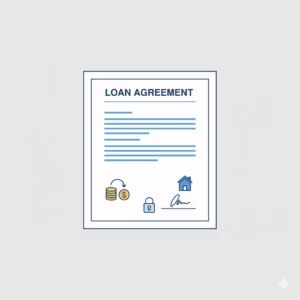What you need to be approved for a loan (credit, income, documents)
Learn how to improve your chances of getting your loan approved

Getting a loan can feel like a mystery. Whether you’re trying to buy a car, consolidate debt, fund a home renovation, or cover an unexpected emergency, the application process can be intimidating. You fill out forms, provide sensitive information, and then wait, hoping for a “yes.”
But what’s actually happening behind the scenes? What separates an “Approved” stamp from a “Denied” letter?
It’s not magic. Lenders, from big banks to online credit unions, follow a surprisingly logical process called underwriting. They are essentially trying to answer one single question: “If we lend this person money, what is the statistical probability they will pay it back on time and in full?”
To answer that, they focus on three core pillars of your financial life: Credit, Income, and Assets.
This guide will demystify the entire process. We’ll break down exactly what you need to get approved for a loan, how lenders analyze your information, and what you can do before you apply to drastically increase your chances of success.
Decoding Your Credit Score: The Number That Matters Most

Your credit score is often the first thing a lender looks at. Think of it as your financial report card. It’s a three-digit number that summarizes your history of borrowing and repaying money. Lenders use this score to get a quick snapshot of your reliability as a borrower.
In the United States, the two most common scoring models are FICO and VantageScore. While their exact formulas are secret, they both range from 300 (Poor) to 850 (Excellent) and are built from the same data in your credit reports.
Here’s a general breakdown of the score ranges:
- Excellent (800 – 850): You are a top-tier borrower. You’ll have access to the best loans with the lowest possible interest rates.
- Very Good (740 – 799): You are considered very dependable. You’ll still get excellent rates and be approved for most loans.
- Good (670 – 739): This is the average range for Americans. You are seen as a “safe” bet and will likely be approved, though your interest rates might be slightly higher than the top tiers.
- Fair (580 – 669): You are in the “subprime” category. You may still get approved for some loans (especially secured ones), but you will face higher interest rates and stricter terms.
- Poor (< 580): You are considered a high-risk borrower. It will be very difficult to get a traditional loan, and you may need to look at options for building or repairing credit first.
What Actually Makes Up Your Credit Score?
Your score isn’t just one thing. It’s a blend of five different factors, each with a different level of importance.
- Payment History (35% of your score): This is the single most important factor. Do you pay your bills on time? A history of late payments, collections, or a bankruptcy will significantly lower your score.
- Credit Utilization (30% of your score): This is the ratio of how much you owe on your credit cards compared to your total credit limit. If you have a $10,000 credit limit and a $5,000 balance, your utilization is 50%. Lenders see high utilization as a sign of financial distress. Pro Tip: Most experts recommend keeping your overall utilization below 30%, and ideally below 10%, for the best score.
- Length of Credit History (15% of your score): How long have you been using credit? A longer history (measured by the average age of all your accounts) shows lenders a more stable and predictable pattern. This is why you shouldn’t be quick to close your oldest credit card.
- Credit Mix (10% of your score): Lenders like to see that you can responsibly manage different types of credit, such as “revolving credit” (like credit cards) and “installment loans” (like auto loans or mortgages).
- New Credit (10% of your score): This looks at how many new accounts you’ve opened recently and how many “hard inquiries” are on your report. A hard inquiry happens every time you apply for a loan. Too many in a short period can make you look desperate for cash, which is a red flag.
Beyond Your Paycheck: How Lenders Analyze Your Income
Your credit score shows your willingness to pay. Your income shows your ability to pay. A lender needs to be confident that you have enough cash flow each month to cover your new loan payment in addition to all your other existing obligations.
But it’s not just about the total number on your paycheck. Lenders are looking for two key things: stability and sufficiency.
Income Stability: Are You a Secure Bet?
A lender wants to see income that is consistent, reliable, and likely to continue.
- For W-2 Employees: This is the most straightforward. Lenders will typically want to see your last two years of W-2s and your most recent pay stubs (from the last 30 days). They want to confirm you’ve been at your job (or at least in the same industry) for a solid period, usually two years. Hopping between jobs every few months can be a red flag.
- For Self-Employed Individuals, Freelancers, and Business Owners: This is more complex. Your income isn’t a simple paycheck; it fluctuates. A lender can’t just look at one good month. They will require much more documentation, including:
- Two years of personal tax returns (all schedules, especially Schedule C or K-1).
- Two years of business tax returns (if you have a separate entity).
- Recent Profit & Loss (P&L) statements and balance sheets.
- Several months of business and personal bank statements to show consistent cash flow.
- Lenders will typically average your income over the past 24 months to get a conservative, reliable number.
- Other Income: What about income from other sources? Yes, it often counts, but it must be provable and consistent. This includes:
- Social Security benefits
- Pension or retirement distributions
- Disability income
- Alimony or child support (if you choose to disclose it and can provide court orders/proof of consistent receipt)
- Investment dividends
Income Sufficiency: The DTI “Secret Weapon”
This brings us to the most important metric you’ve probably never heard of: your Debt-to-Income (DTI) ratio. This single number is often more important than your income itself.
What is DTI? Your DTI is the percentage of your gross monthly income (before taxes) that goes toward paying your monthly debt obligations.
How to Calculate Your DTI:
- Add up all your monthly debt payments: This includes your rent or mortgage payment, auto loan payments, student loan payments, personal loan payments, and the minimum monthly payments on all your credit cards.
- Divide that total by your gross monthly income.
- Multiply by 100 to get a percentage.
Example:
- Gross Monthly Income: $5,000
- Monthly Debts:
- Rent: $1,500
- Car Payment: $300
- Student Loans: $200
- Credit Card Minimums: $100
- Total Monthly Debt: $2,100
- Calculation: ($2,100 / $5,000) * 100 = 42% DTI
Why DTI is the “Secret Killer” of Loan Applications:
You could have a $100,000 salary, but if you also have $4,000 in monthly debt payments (a 48% DTI), you have very little room in your budget for a new loan. A lender sees this and worries you’re “over-leveraged.”
- What’s a “good” DTI?
- 36% or less: You are in great shape. Lenders see you as having plenty of room to take on new debt.
- 37% to 43%: This is an acceptable range. You will likely still be approved, especially with a good credit score.
- 44% to 50%: This is the high end. You may be approved for some types of loans (like FHA mortgages) but will face more scrutiny.
- Over 50%: It will be very difficult to get approved for a traditional loan.
The “Paper Trail”: Exactly What Documents You’ll Need

Lenders can’t just take your word for it. They must verify every piece of information you put on your application. This is where the “paper trail” comes in. Getting these documents organized before you apply will make the process infinitely smoother.
Here is a comprehensive checklist of what you’ll likely need.
1. Identity Verification
This proves you are who you say you are.
- Valid, government-issued photo ID: Driver’s License, U.S. Passport, or State ID.
- Social Security Number (SSN): They will ask for the number; you usually don’t need the physical card, but they use it to pull your credit report.
- Proof of Address: A recent utility bill, bank statement, or lease agreement that matches the address on your application.
2. Income Verification (W-2 Employee)
This proves your income and job stability.
- Recent Pay Stubs: Usually covering the last 30 days.
- W-2 Forms: For the past two years.
- Recent Tax Returns: Sometimes required, especially if you earn commission or bonuses.
- Verification of Employment: The lender will almost always call your employer’s HR department to confirm you still work there.
3. Income Verification (Self-Employed)
This proves your business is stable and profitable.
- Personal Tax Returns: Two most recent years (all pages and schedules).
- Business Tax Returns: Two most recent years (if applicable).
- Year-to-Date Profit & Loss (P&L) Statement: To show how your business is doing this year.
- Recent Bank Statements: Often 3-6 months of both personal and business accounts to show cash flow.
- Form 1099s: From your clients to cross-reference your stated income.
4. Asset Verification
This shows you have “capacity” and aren’t living paycheck-to-paycheck.
- Bank Statements: For the last two or three months (checking and savings). Lenders look for consistent balances and flag any large, unusual deposits (as they could be an undisclosed loan from someone else).
- Investment Account Statements: 401(k), IRA, brokerage account statements. This shows you have a financial cushion.
Does the Type of Loan Change What You Need?
Yes, absolutely. The general requirements are the same (credit, income, DTI), but the emphasis changes based on what you’re borrowing and why. The main difference is Secured vs. Unsecured loans.
Unsecured Loans (Higher Risk for Lenders)
These loans are not backed by any physical asset. If you stop paying, the lender can’t just come and take your “stuff.” They have to sue you, which is expensive and time-consuming.
- Examples: Personal loans, credit cards, student loans.
- What Lenders Focus On: Because there’s no collateral, your Credit Score and DTI are extremely important. Lenders need to be exceptionally confident in your personal reliability. This is why unsecured loans typically have higher interest rates.
Secured Loans (Lower Risk for Lenders)
These loans are “secured” by an asset, known as collateral. If you default, the lender can seize the asset to get their money back.
- Examples: Mortgages (collateral = the house), Auto Loans (collateral = the car).
- What Lenders Focus On: Your credit and DTI still matter, but the lender has a safety net. They are also intensely focused on:
- The Value of the Asset: They will order an appraisal (for a home) or check the book value (for a car) to make sure the asset is worth the loan amount.
- Your Down Payment: A down payment is your “skin in the game.” For a mortgage, putting 20% down lowers the lender’s risk and shows your financial strength. For a car, a down payment reduces the chance of you being “underwater” (owing more than the car is worth).
How to Improve Your Loan Approval Odds (Before You Apply)

If you’re reading this and feeling worried about your chances, don’t be. The best time to fix a problem is before it becomes one. Here are actionable steps you can take right now to become the “perfect” loan applicant.
1. Check Your Credit Report for Free
Before a lender sees it, you should see it. You are legally entitled to one free credit report from each of the three major bureaus (Experian, Equifax, TransUnion) every year.
- Go to:
AnnualCreditReport.com(this is the only official, government-mandated site). - What to look for:
- Errors: Is there a late payment listed that you know you paid on time? An account you don’t recognize? Get these disputed and fixed immediately.
- High Balances: Note which credit cards have the highest utilization.
2. Pay Down Your “Revolving” Debt
This is the fastest way to boost your credit score and lower your DTI simultaneously. Focus on paying down your credit card balances. If you can get your total utilization below 30%, your score will almost certainly increase.
3. Do NOT Apply for New Credit
Resist the urge to open that new store credit card to “save 15%.” Every time you apply for credit, it generates a hard inquiry, which can temporarily dip your score. Lenders get nervous if they see a flurry of recent applications.
4. Do NOT Close Old Accounts
It seems logical: “I finally paid off this old credit card, so I’ll close it.” Don’t. Closing an old account reduces your total available credit (which hurts your utilization) and lowers the average age of your credit history (which also hurts your score). Just cut up the card if you don’t trust yourself, but leave the account open.
5. Stabilize Your Banking
Lenders get spooked by chaos. Avoid overdrafts, non-sufficient funds (NSF) fees, and large, undocumented cash deposits. A clean, stable bank statement with a healthy buffer is a beautiful sight to an underwriter.
6. Get Pre-Qualified
Before you do a full application, ask a lender for a pre-qualification. This is usually a “soft” credit pull (which doesn’t hurt your score) where you self-report your income and debts. It gives you a realistic idea of what you can afford and uncovers any obvious red flags before you get a hard “no.”
What to Do If Your Loan Application is Denied

First, don’t panic or be embarrassed. It happens to millions of people. Second, you have rights.
By law (the Equal Credit Opportunity Act), the lender must provide you with an Adverse Action Notice. This is a formal letter that must state the specific, primary reasons why you were denied.
It won’t just say “bad credit.” It will be specific:
- “Debt-to-income ratio too high”
- “History of delinquent payments”
- “Insufficient income for loan amount”
- “Length of employment”
- “Unable to verify identity”
This notice is not a rejection; it’s a roadmap. It is your free, personalized guide to what you need to fix.
- If it’s DTI: You need to either (a) increase your income or (b) pay off an existing debt (like a small loan) to lower your monthly obligations.
- If it’s your credit score: Pull your report again. Look at the “Payment History” or “Utilization” and start rebuilding.
- If it’s income: You may need to wait until you have a longer job history or can show more stable self-employment income.
Do the work, wait 6-12 months, and apply again from a position of strength.
Your Final Pre-Application Checklist
Getting a loan is a major financial step, but it doesn’t have to be a confusing one. By understanding what lenders are looking for, you can take control of the process.
Before you click “submit” on that next application, run through this final checklist.
- [ ] Do I know my credit score?
- [ ] Have I reviewed my full credit report for errors?
- [ ] Is my credit card utilization below 30%?
- [ ] Have I calculated my Debt-to-Income (DTI) ratio?
- [ ] Is my DTI under 43%?
- [ ] Do I have my last two years of W-2s or tax returns?
- [ ] Do I have my last two months of bank statements?
- [ ] Do I have my last 30 days of pay stubs?
- [ ] Have I avoided opening any new credit accounts in the last 6 months?
If you can check “yes” to all of these, you are not just applying for a loan. You are demonstrating that you are a responsible, reliable, and low-risk borrower. And that is the key to hearing “you’re approved.”





